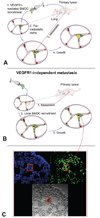Premetastatic lung "niche": is vascular endothelial growth factor receptor 1 activation required?
- PMID: 20587530
- PMCID: PMC2919170
- DOI: 10.1158/0008-5472.CAN-10-0119
Premetastatic lung "niche": is vascular endothelial growth factor receptor 1 activation required?
Abstract
Inflammatory pathways may mediate preparation of the "metastatic soil" in the lungs. Some of these pathways--activation and/or the recruitment of certain inflammatory cells--might depend on vascular endothelial growth factor receptor 1 (VEGFR1) activity. Thus, blocking the activity of VEGFR1 (or the interaction with its ligands) has emerged as a potential antimetastasis strategy to target not only angiogenesis and cancer cell survival and migration, but also the recruitment of tumor growth-promoting bone marrow-derived cells (BMDC). However, inhibition of VEGFR1 activity by blocking antibodies or by genetic deletion of the tyrosine kinase domain neither prevented nor changed the rate of spontaneous metastasis formation after surgical removal of primary tumors. Thus, development of VEGFR1-targeted agents should be pursued in selected tumors (e.g., by identifying cancers that depend on VEGFR1 signaling for survival) or in specific combination therapies. Preventing metastasis will likely require identification and blockade of additional or alternative proinflammatory pathways that mediate the priming of the metastatic soil and the growth of micrometastases.
(c)2010 AACR.
Figures

Similar articles
-
VEGFR1 activity modulates myeloid cell infiltration in growing lung metastases but is not required for spontaneous metastasis formation.PLoS One. 2009 Sep 18;4(9):e6525. doi: 10.1371/journal.pone.0006525. PLoS One. 2009. PMID: 19763275 Free PMC article.
-
VEGFR1-activity-independent metastasis formation.Nature. 2009 Sep 17;461(7262):E4; discussion E5. doi: 10.1038/nature08254. Nature. 2009. PMID: 19759568 Free PMC article.
-
Effects of VEGFR1+ hematopoietic progenitor cells on pre-metastatic niche formation and in vivo metastasis of breast cancer cells.J Cancer Res Clin Oncol. 2019 Feb;145(2):411-427. doi: 10.1007/s00432-018-2802-6. Epub 2018 Nov 27. J Cancer Res Clin Oncol. 2019. PMID: 30483898 Free PMC article.
-
Differential roles of vascular endothelial growth factor receptor-1 and receptor-2 in angiogenesis.J Biochem Mol Biol. 2006 Sep 30;39(5):469-78. doi: 10.5483/bmbrep.2006.39.5.469. J Biochem Mol Biol. 2006. PMID: 17002866 Review.
-
Positive and negative modulation of angiogenesis by VEGFR1 ligands.Sci Signal. 2009 Feb 24;2(59):re1. doi: 10.1126/scisignal.259re1. Sci Signal. 2009. PMID: 19244214 Review.
Cited by
-
Systemic Reprogramming of Endothelial Cell Signaling in Metastasis and Cachexia.Physiology (Bethesda). 2023 Jul 1;38(4):0. doi: 10.1152/physiol.00001.2023. Physiology (Bethesda). 2023. PMID: 37222464 Free PMC article. Review.
-
Exosomal Annexin II Promotes Angiogenesis and Breast Cancer Metastasis.Mol Cancer Res. 2017 Jan;15(1):93-105. doi: 10.1158/1541-7786.MCR-16-0163. Epub 2016 Oct 19. Mol Cancer Res. 2017. PMID: 27760843 Free PMC article.
-
TIMP-2 targets tumor-associated myeloid suppressor cells with effects in cancer immune dysfunction and angiogenesis.J Immunother. 2012 Jul;35(6):502-12. doi: 10.1097/CJI.0b013e3182619c8e. J Immunother. 2012. PMID: 22735808 Free PMC article.
-
Premetastatic Niche: A Novel Area for Research in Metastasis with a Potential as Therapeutic Targeting in Oral Cancer.J Pharm Bioallied Sci. 2023 Jul;15(Suppl 1):S36-S39. doi: 10.4103/jpbs.jpbs_49_23. Epub 2023 Jul 5. J Pharm Bioallied Sci. 2023. PMID: 37654347 Free PMC article. Review.
-
Initial steps of metastasis: cell invasion and endothelial transmigration.Mutat Res. 2011 Jul-Oct;728(1-2):23-34. doi: 10.1016/j.mrrev.2011.05.002. Epub 2011 May 12. Mutat Res. 2011. PMID: 21605699 Free PMC article. Review.
References
-
- Fidler IJ. The pathogenesis of cancer metastasis: the 'seed and soil' hypothesis revisited. Nat Rev Cancer. 2003;3:453–458. - PubMed
-
- Nguyen DX, Bos PD, Massague J. Metastasis: from dissemination to organ-specific colonization. Nat Rev Cancer. 2009;9:274–284. - PubMed
-
- Hiratsuka S, Nakamura K, Iwai S, et al. MMP9 induction by vascular endothelial growth factor receptor-1 is involved in lung-specific metastasis. Cancer Cell. 2002;2:289–300. - PubMed
Publication types
MeSH terms
Substances
Grants and funding
- T32 CA073479/CA/NCI NIH HHS/United States
- R01 CA126642/CA/NCI NIH HHS/United States
- R01 CA085140/CA/NCI NIH HHS/United States
- R21 CA139168/CA/NCI NIH HHS/United States
- R01-CA115767/CA/NCI NIH HHS/United States
- P01-CA80124/CA/NCI NIH HHS/United States
- R01 CA159258/CA/NCI NIH HHS/United States
- R01-CA85140/CA/NCI NIH HHS/United States
- R01 CA115767/CA/NCI NIH HHS/United States
- P01 CA080124/CA/NCI NIH HHS/United States
- R21-CA139168/CA/NCI NIH HHS/United States
- R01-CA126642/CA/NCI NIH HHS/United States
- R24 CA085140/CA/NCI NIH HHS/United States
- T32-CA73479/CA/NCI NIH HHS/United States
LinkOut - more resources
Full Text Sources
Medical

